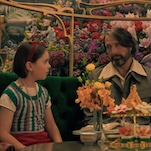Ah, the pleasures of a 40 minute chase scene. Shot in black and white and following the adventures of a woman (Maxine Peak) trying to escape a vicious robot “dog,” there’s not a lot of frills on display in “Metalhead.” Dialogue is limited, essentially non-existent after the first 10 minutes, and world-building is done largely by implication. It’s a world where bad things have happened and are continuing to happen, and there’s a definite point of view about all of it, but for most of the running time, all that really matters is desperate protagonist trying to escape a horrible technology.
The two stars of the hour are Peak (I don’t think her character is ever named, although I may have missed it) and the metal monster chasing her. Peak is easy to root for, and while part of that is simply the design of the script, the actress does a good job of finding new ways to be terrified, angry, triumphant, and depressed. She makes the most of her few opportunities to do more than simply react to her situation, which makes her fate all the more upsetting. The episode’s focus is both its great strength and its great weakness, as the narrowness of intent that generates tension also prevents more complicated emotional reactions. I wouldn’t say Peak rises above this, but she doesn’t need to, and the simple fact that she registers as more than just an archetype is enough.
The metal monster needs personality too, and it’s impressive just how much the special effects team is able to get out of what is essentially a box on legs. It never looks anything but creepily real, and while the black and white camera work helps (the look here both fits the mood of the story and covers for any potential dodginess in the CGI), the design of the thing, from its appearance to the way it moves, deserves the bulk of the praise. I think its the legs that really sell it. The way they scramble for purchase and dart across the landscape is both cartoonish and eerily familiar. Peak calls the thing a “dog,” but looks more like a cat to me—but whatever animal you settle on, it’s just enough life to make it more than a simple weapon.
There’s also some world-building happening on the sidelines, which, for my money, is where world-building rightly belongs. Black Mirror is, in general, very good at this sort of thing. Even the weakest episodes manage to toss off information either visually or conversationally in ways that feel satisfyingly real. The show gets a lot of credit for Brooker’s knack for coming up with “Wait, is that a real thing?” tech, but part of the reason that tech is so convincing is the confidence with which it’s presented. While there are certainly scenes of people explaining concepts, most of the show’s most interesting ideas are offered as things that have already been around long enough that no one is all that surprised by them anymore.
That’s taken to logical, frightening extremes here. The three people we start the episode with clearly understand the stakes and dangers of their world, and there’s no outsider figure who needs to get brought up to speed. The threat is so omnipresent and constant that there’s little reason to discuss it beyond the immediate problems, and when the robot’s first victim discovers the machine hiding behind a box, there’s surprise but no confusion. The “dogs” are a constant in this world, and the characters’ acceptance goes a long way to ensure our own.
It also works to serve the episode’s single main thematic point as well. Whatever context originally lead the creation of the “dogs” no longer seems relevant. What we see of the world in “Metalhead” is a wasteland populated with corpses; midway through the episode, Peak finds a house like a fortress with a pair of corpses on the bed inside. The only people left are dying and scrounging for scraps. The world the machines were built to protect is no longer relevant, but the machines remain, killing to protect teddy bears. The final sequence showing a horde of machines swarming in on the briefly triumphant but doomed protagonist, is as bitter as the show has ever been. She deserved better.
Stray observations
- This one reminded me a bit of Philip K. Dick’s terrific short story “Second Variety.” (Which was adapted into the not terrible Screamers starring Peter Weller.) It’s more a thematic thing than plot details.








































